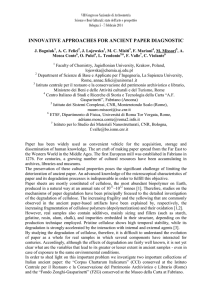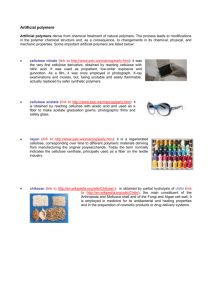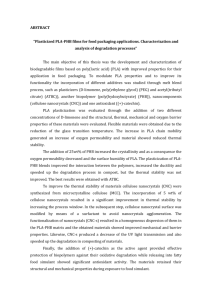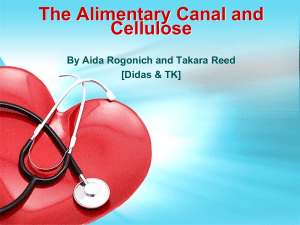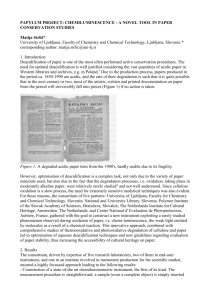STABILISATION OF ALKALINE CELLULOSE WITH HALIDES AND
advertisement
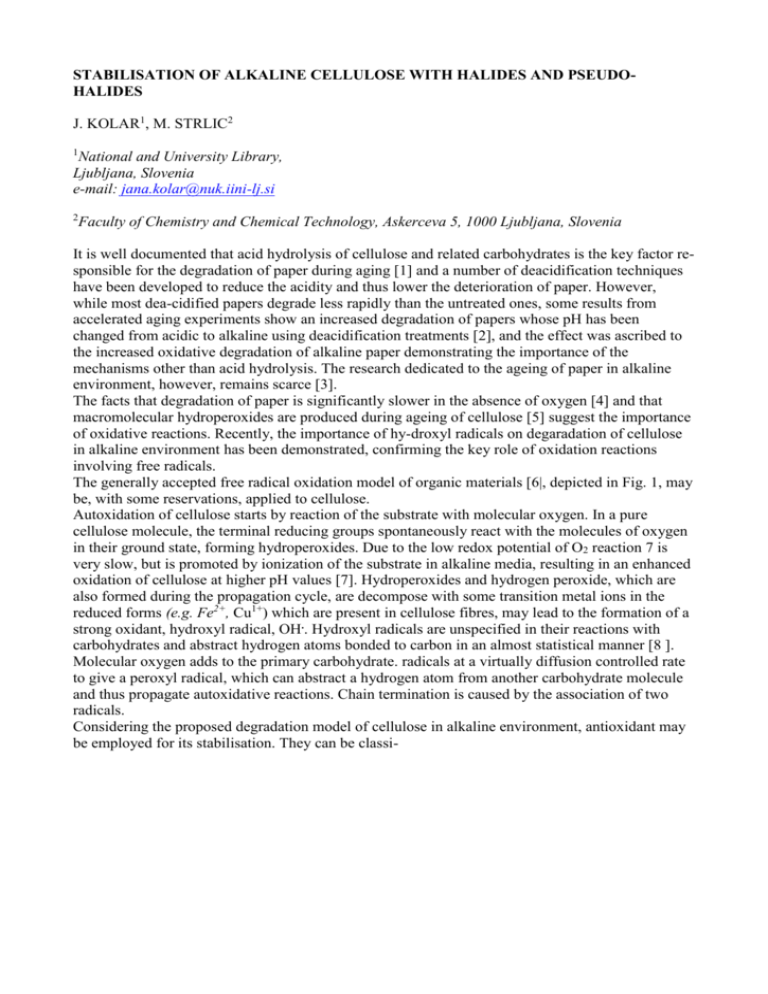
STABILISATION OF ALKALINE CELLULOSE WITH HALIDES AND PSEUDOHALIDES J. KOLAR1, M. STRLIC2 1 National and University Library, Ljubljana, Slovenia e-mail: jana.kolar@nuk.iini-lj.si 2 Faculty of Chemistry and Chemical Technology, Askerceva 5, 1000 Ljubljana, Slovenia It is well documented that acid hydrolysis of cellulose and related carbohydrates is the key factor responsible for the degradation of paper during aging [1] and a number of deacidification techniques have been developed to reduce the acidity and thus lower the deterioration of paper. However, while most dea-cidified papers degrade less rapidly than the untreated ones, some results from accelerated aging experiments show an increased degradation of papers whose pH has been changed from acidic to alkaline using deacidification treatments [2], and the effect was ascribed to the increased oxidative degradation of alkaline paper demonstrating the importance of the mechanisms other than acid hydrolysis. The research dedicated to the ageing of paper in alkaline environment, however, remains scarce [3]. The facts that degradation of paper is significantly slower in the absence of oxygen [4] and that macromolecular hydroperoxides are produced during ageing of cellulose [5] suggest the importance of oxidative reactions. Recently, the importance of hy-droxyl radicals on degaradation of cellulose in alkaline environment has been demonstrated, confirming the key role of oxidation reactions involving free radicals. The generally accepted free radical oxidation model of organic materials [6|, depicted in Fig. 1, may be, with some reservations, applied to cellulose. Autoxidation of cellulose starts by reaction of the substrate with molecular oxygen. In a pure cellulose molecule, the terminal reducing groups spontaneously react with the molecules of oxygen in their ground state, forming hydroperoxides. Due to the low redox potential of O2 reaction 7 is very slow, but is promoted by ionization of the substrate in alkaline media, resulting in an enhanced oxidation of cellulose at higher pH values [7]. Hydroperoxides and hydrogen peroxide, which are also formed during the propagation cycle, are decompose with some transition metal ions in the reduced forms (e.g. Fe2+, Cu1+) which are present in cellulose fibres, may lead to the formation of a strong oxidant, hydroxyl radical, OH.. Hydroxyl radicals are unspecified in their reactions with carbohydrates and abstract hydrogen atoms bonded to carbon in an almost statistical manner [8 ]. Molecular oxygen adds to the primary carbohydrate. radicals at a virtually diffusion controlled rate to give a peroxyl radical, which can abstract a hydrogen atom from another carbohydrate molecule and thus propagate autoxidative reactions. Chain termination is caused by the association of two radicals. Considering the proposed degradation model of cellulose in alkaline environment, antioxidant may be employed for its stabilisation. They can be classi- Fig. 1. Model of auto-oxidative degradation of organic materials. fied as either "preventive" or "chain breaking". The primary function of 'preventive' anti-oxidants is to stop radical formation by reducing the rate of chain initiation, either inactivating the corrosive metal ions (e.g. phytate) or by the heterolytic decomposition of peroxides (e.g. KI) [9]. The antioxidants classified as "chain breaking" react with radicals that have already formed in order to form more stable products. As a result they interfere with the mechanism of chain propagation. Lignin may belong within this group of antioxidants. In the present study, the effects of halides KI and NaBr as well as pseudo-halide KSCN on ageing of cellulose in alkaline environment is studied. The later two, like the better-known iodide may act as a catalytic peroxide decomposer. Experiments were performed with (Whatman filter paper no. 1; 86.0 g m-2, degree of polymerisation (DP): 2630, RSD 0.74 %. The cellulose samples were deacidified by immersion into aqueous solutions of Ca(HCO3)2 0.01 mol L-1 for 1 hour. Dry samples were immersed into 0.01 mol L-1 aqueous solution of antioxidants (KI, NaBr or KSCN) for 5 minutes. Results of degree of polymerisation after 48 days of accelerated ageing at 80 °C and RH 65 % (Votsch Climatic test Chamber Type VC 0020) are presented in Figure 2. Addition of all of the antioxidants increased ageing stability of deacidified paper, with the stabilising activity decreasing in order I- > SCN- > Br-. Fig. 2. Degree of polymerisation of Whatman cellulose, deacidified using Ca(HCO3)2 (C), or with added KI (CI). NaBr (CBr) or KSCN (CKSCN) after 48 days of accelerated ageing (80°C 65 % RH). Error bar represents RSD. Fig. 3. Diffuse reflectance at 457 nm (%) of Whatman cellulose, deacidified using Ca(HCO3)2 (C), or with added KI (CI), NaBr (CBr) or KSCN (CKSCN) after 14 days of thermal accelerated ageing (80 °C, 65 % RH) or 3 days of photoageing (500 Wm2, 35 °C). Error bar represents R.S.D. However, a discolouration of the samples containing the KI and KSCN is observed (Figure 3). No such discolouration was observed during the exposure of the samples to the filtered Xe-lamp in Heraeus Suntest CPS+ apparatus. As evident from the Figure 3, addition of KSCN even increased colour stability of Whatman paper. Results presented show that effective stabilisation of paper in alkaline environment may be achieved with the addition of bromide, iodide and rhodanide. While iodide and rhodanide may induce discolouration, this is not observed with bromide, which thus bears potential for improving the most often used conservation process - aqueous and non-aqueous deacidification of paper. REFERENCES 1. Zou, X., Gurnagul, N., Uesaka, T., Bouchard, J., "Accelerated aging of papers of pure cellulose: mechanism of cellulose degradation and paper embrittlement" Polym. Deg. Stab. 43: 393-402 (1994). 2. Kolar, J., Novak, G., "Effect of Various Deacidification Solutions on the Stability of Cellulose Pulps" Restaurator; 17: 25-31 (1996). 3. Kolar, J.. "Mechanism of Autoxidative Degradation of Cellulose" Restaurator, 18: 163-76 (1997). 4. Major, W. D., "The degradation of Cellulose in Oxygen and Nitrogen at High Temperatures", Tappi, 41:530-44(1958). 5. Marraccini, L. M., Kleinert, TN., "Aging and Colour Reversion of Bleached Pulps. Part I. Peroxide Formation During Aging", Svensk Papperstidn., 126-31 (1962). 6. Bolland, J. L., Gee, G., Trans. Faraday Soc. 42: 236,(1946). 7. Malesic, J., Kolar, J., Strlic, M., "Effect of pH and Carbonyls on the Degradation of Alkaline Paper. Factors Affecting Ageing of Alkaline Paper", Reastaurator, 23: 145—53 (2002). 8. Schuchmann, M. N., Von Sonntag, C, "Radiation chemistry of carbohydrates. Part 14. Hydroxyl radical induced oxidation of oGlucose in oxygenated aqueous solution", J. Chem. Soc. Perkin. Trans. 2: 1958-63 (1977). 9. Kolar, J., Strlic. M., Novak, G.. Pihlar, B.. "Aging and Stabilization of Alkaline Paper", J. Pulp Pap. Sci. 24:89-94(1998).
